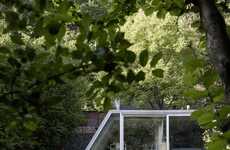
This Eco-Friendly Residence Considers Site Impact
Vasiliki Marapas — July 30, 2014 — Art & Design
References: heliotropearchitects & contemporist
Heliotrope Architects designed the 'Suncrest Residence,' an eco-friendly residence located on Washington's Orcas Island.
Surrounded by a majestic pacific madrone forest, the home is a work of architecture that takes the ecologically sensitive site into consideration. In order to optimize for the view, the home is located in a rocky clearing that keeps the sea line visible. To remove as few trees as possible, the home wraps around an outcropping rock. Stormwater issues were addressed by piping rain leaders into a nearby pond, allowing for natural filtration. A roof garden deals with the excess.
The architects oriented the home along a narrow floorplan that allows every room a view of the sea, without compromising the overall connection to the forest. Wood and concrete were chosen as materials that would harmonize with the environment.
Surrounded by a majestic pacific madrone forest, the home is a work of architecture that takes the ecologically sensitive site into consideration. In order to optimize for the view, the home is located in a rocky clearing that keeps the sea line visible. To remove as few trees as possible, the home wraps around an outcropping rock. Stormwater issues were addressed by piping rain leaders into a nearby pond, allowing for natural filtration. A roof garden deals with the excess.
The architects oriented the home along a narrow floorplan that allows every room a view of the sea, without compromising the overall connection to the forest. Wood and concrete were chosen as materials that would harmonize with the environment.
Trend Themes
1. Eco-friendly Architecture - Disruptive innovation opportunity: Develop innovative construction materials and techniques that minimize environmental impact while providing functional and aesthetically pleasing designs.
2. Site-specific Design - Disruptive innovation opportunity: Use advanced data analysis and modeling to design buildings that seamlessly blend with and minimize disruption to natural surroundings.
3. Integrated Sustainable Systems - Disruptive innovation opportunity: Create advanced systems that seamlessly integrate natural elements, such as rainwater collection and filtration, into architectural designs.
Industry Implications
1. Architecture and Construction - Disruptive innovation opportunity: Explore novel ways to incorporate eco-friendly and sustainable practices into architectural designs, materials, and construction methodologies.
2. Environmental Engineering - Disruptive innovation opportunity: Develop cutting-edge technologies and approaches to mitigate environmental impact in construction projects, such as efficient stormwater management and eco-sensitive site planning.
3. Green Building Solutions - Disruptive innovation opportunity: Provide innovative solutions and products that help architects and builders create environmentally sustainable structures, such as energy-efficient systems and eco-conscious materials.
5.2
Score
Popularity
Activity
Freshness























